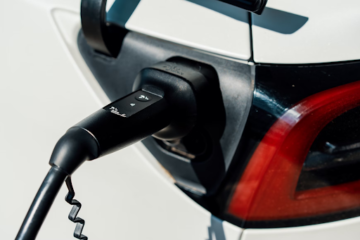The iPhone XR belongs to the tribe of solid iPhones under budget which still hold their ground. It debuted in 2018 and superseded the iPhone X, released a year earlier.
With a decent-sized 6.1-inch display, a fast performance, and good camera results, this iPhone has some great perks at an attractive budget price.
Yes, there are some features you might miss like the Night mode and 5G, but this is perfectly shadowed by the perks you are getting.
This iPhone XR review will dive deep into everything you might be interested in from camera features to design to battery life.
Let’s get right into it.
iPhone XR Design
The iPhone XR features a glass and aluminium design with a 6.1-inch LCD display. The iPhone XR has a glass front and back, with an aluminium frame. This design is similar to the iPhone XS but with a more affordable price point.
The iPhone XR comes in six colours: White, Black, Blue, Yellow, Coral, and Red. The colours are a mix of classic and new options, with the Coral and Yellow options being particularly unique.
The iPhone XR has a similar design to the iPhone XS, with a rounded edge and a notch at the top. However, it is slightly larger and thicker than the iPhone XS.
The iPhone XR has a 6.1-inch LCD display with a resolution of 1792 x 828 pixels. This is lower than the iPhone XS, which has a 5.8-inch OLED display with a resolution of 2436 x 1125 pixels.
The iPhone XR has a noticeable bezel around the display, which can make it seem smaller than it is. This is particularly noticeable on the black model, where the bezel blends with the black frame.
The iPhone XR has a single rear camera, which is a significant departure from the dual cameras on the iPhone XS. The camera is positioned in a bump on the back of the phone, which can be a bit awkward to handle.
The iPhone XR has the same button layout as the iPhone XS, with the large Siri/lock button on the right side and the volume buttons and silencer rocker on the left side.
iPhone XR Display
The iPhone XR features a 6.1-inch Liquid Retina HD display with a resolution of 1792 x 828 pixels at 326 ppi. The display is an all-screen LCD with IPS technology and supports True Tone, a wide colour gamut, and haptic touch. It has a maximum brightness of 625 nits and a contrast ratio of 1400:1. The display also has rounded corners that follow a beautiful curved design, and these corners are within a standard rectangle. When measured as a standard rectangular shape, the screen is 6.06 inches diagonally (the actual viewable area is less).
iPhone XR Performance
The iPhone XR features a powerful A12 Bionic chip, which provides fast performance and efficient battery life.
The iPhone XR uses the same A12 Bionic chip as the iPhone XS, which provides fast performance and efficient battery life.
The chip has 6 CPU cores, with 2 high-performance cores and 4 high-efficiency cores.
The chip has an Apple A12 GPU with 256 GPU shading units and a clock speed of 1100 MHz.
The chip has a Neural Engine for AI-driven functions, which provides significant improvements in machine learning tasks.
The iPhone XR scored 11,312 on Geekbench 4, which is comparable to the scores from the iPhone XS and iPhone XS Max.
The iPhone XR performed well in gaming tests, with smooth performance in augmented reality games like AR Blast.
The iPhone XR took just 40 seconds to convert a 4K clip to 1080p, which is faster than the Pixel 3 XL and Galaxy S10e.
The iPhone XR scored 4,416 on 3DMark’s Slingshot Extreme Unlimited test, which is comparable to the scores from the Pixel 3 XL and Galaxy Note 9.
iPhone XR Camera
The iPhone XR camera performance is decent and does a good job in most lighting situations. Here are some key points about the camera performance:
Main Camera
– 12MP Wide Camera: The iPhone XR has a single 12MP f/1.8 camera on the back with OIS and quad-LED two-tone flash.
– Video Recording: The camera can record videos in up to 4K60, with optical image stabilization and digital zoom of up to 5x.
– Portrait Mode: The iPhone XR has a single-lens Portrait mode that uses advanced bokeh and Depth Control, but it does not have a secondary telephoto lens, which means it cannot take portrait images of objects or non-human subjects.
– Smart HDR: The camera supports Smart HDR for photos, which uses computational knowledge to alter contrast, white balance, and other settings to improve the image.
– Low-Light Performance: The iPhone XR’s camera performance tends to drop in low-light environments, producing grainy and noisy photos.
Front Camera
– 7MP TrueDepth Camera: The front camera is a single 7MP f/2.2 camera with Smart HDR and the ability to shoot 1080p60 videos.
– Portrait Mode: The front camera also supports Portrait mode with advanced bokeh and Depth Control, but it only works for people and not for objects or non-human subjects.
Video Features
– 4K Video Recording: The iPhone XR can record 4K videos at 24 fps, 30 fps, or 60 fps, with optical image stabilization and digital zoom up to 3x.
– Slow-Motion Video: The camera can record slow-motion videos in 1080p at 120 fps or 240 fps.
– Time-Lapse Video: The iPhone XR supports time-lapse video with stabilization.
Comparison
– iPhone XS and XS Max: The iPhone XR’s camera performance is similar to the iPhone XS and XS Max, but it lacks the secondary telephoto lens and some advanced features like the ability to take portrait images of objects or non-human subjects.
– Pixel 3 XL: The iPhone XR’s camera performance is comparable to the Pixel 3 XL, but it lacks some advanced features like Night Mode and the ability to take portrait images of objects or non-human subjects.
Overall, the iPhone XR camera is decent and performs well in most lighting situations, but it lacks some advanced features and may not match up to the standard of newer iPhone models like the iPhone 14 or iPhone 14 Pro.
iPhone XR Battery Life
The iPhone XR battery and charging performance are decent and provide a good balance between power and efficiency.
The iPhone XR has a battery capacity of 2942 mAh, which is slightly lower than the iPhone XS Max but higher than the iPhone XS.
The iPhone XR has a talk time of up to 25 hours, which is longer than the iPhone XS but shorter than the iPhone XS Max.
Internet Use: The iPhone XR has an internet use time of up to 15 hours, which is shorter than the iPhone XS Max but longer than the iPhone XS.
The iPhone XR has a video playback time of up to 16 hours, which is shorter than the iPhone XS Max but longer than the iPhone XS.
The iPhone XR has an audio playback time of up to 65 hours, which is longer than the iPhone XS Max and iPhone XS.
Charging
The iPhone XR supports fast charging up to 50% in 30 minutes with an 18W charger. The iPhone XR supports wireless charging with Qi chargers. The phone also supports USB charging.
Conclusion
With the iPhone XR, you will be getting some really cool perks compared to some of the pricier smartphones. A big and bright screen, very solid cameras, fast performance, and long battery life are some of its strong features. And you will avail of all these at a very decent price point. If you have budget and you want 5G internet and an OLED display, then you can go with the iPhone 12. But if you are under budget and are willing to skip these two features, then the iPhone XR is a solid choice.
Stay in touch to get more updates & news on Gossips!




